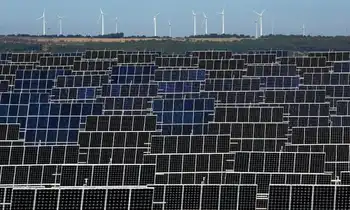Fire touches off power outage across Florida
By St. Petersburg Times
Electrical Testing & Commissioning of Power Systems
Our customized live online or in‑person group training can be delivered to your staff at your location.

- Live Online
- 12 hours Instructor-led
- Group Training Available
Works, that is, but for a small fire in a western Miami-Dade County substation run by FPL. The as-yet unexplained fire caused a cascade of power outages throughout the state.
The fire triggered safety shutdowns of at least five power plants - including two nuclear reactors in South Florida - while simultaneously causing the massive blackout.
At the height of the midday outage, more than 2-million people in 31 counties lacked electricity, including more than 200,000 customers in the Tampa Bay area. The vast majority of customers had power by 6 p.m., according to the state emergency operations center.
But the utilities are claiming success. The blackout protected the system from severe damage that might have caused outages that stretched on far longer than one afternoon, said Mayco Villafana, spokesman for FPL.
"The system worked as it was designed to do," he said.
At a hastily arranged news conference Tuesday evening in St. Petersburg, Gov. Charlie Crist echoed FPL's good cheer.
"What today I think proved is that our utilities are up to the task," Crist said.
So, what happened?
The blackout began around 1:10 p.m. when a disconnect switch at the Miami-Dade substation caught fire, Villafana said. A disconnect switch typically allows utilities to isolate pieces of equipment from the flow of electricity, so workers canfix equipment without getting electrocuted.
The malfunctioning switch created dangerous problems in the way power flows throughout the state's system. Several power plants quickly shut down to protect themselves from critical damage. At FPL's Turkey Point power station, two nuclear reactors and a natural gas plant shut down. Tampa Electric lost two small natural gas plants, one at its Bayside power station and the other in Polk County, said spokeswoman Laura Duda.
All told, the state's interconnected transmission grid abruptly lost about 2,500-megawatts of incoming electricity, enough to power more than 800,000 homes, most of it in FPL territory, said Linda Campbell, vice president of the Florida Reliability Coordinating Council, the organization that sets and enforces reliability standards for Florida's grid.
That sudden loss of power created new problems in the transmission grid, Campbell said. Again, safety features responded by "shedding load," cutting off power to as many as 950,000 customers throughout the state.
In layman's terms, the system turned off your lights to protect itself.
The swiftly widening blackout left utilities scrambling to restore power. In FPL territory, 475,000 customers lost power, as did an additional 475,000 customers throughout the rest of the state, Villafana said. FPL estimated that more than 2-million people lacked power, while the state offered an early estimate of more than 4-million people in the dark.
Drivers crept uneasily through unlit intersections. Miami International Airport switched to backup generators, as did hospitals. Fire-rescue units worked to free people from stalled elevators. A special state House election in Brevard County went on as scheduled with backup generators powering voting machines.
In the Tampa Bay area, power went out to nearly 225,000 locations, most for about an hour. Hardest hit were the areas around the University of South Florida in Tampa, and parts of east Hillsborough County, including Brandon, Riverview and Valrico.
At the USF library, a generator failed, prompting police to start evacuating about 1,000 people down emergency-lit stairways. Police guided traffic along major thoroughfares such as Fletcher and Hillsborough avenues. Traffic signals at U.S. 19 and Gulf-to-Bay in Clearwater went dark. At Eckerd College, some instructors moved classes outdoors. Pasco County public schools canceled after-school activities.
At the height of the outage, about 153,000 Progress Energy customers, 50,000 Tampa Electric customers, and about 19,000 customers of Withlacoochee River Electric Cooperative lost power.
Four Hillsborough County schools were blacked out between 1:05 p.m. and 2:05 p.m., said Linda Cobbe, schools spokeswoman. All were in the FishHawk area: Bevis and Buckhorn elementary schools, Randall Middle School, and Newsome High School.
The state's emergency operations center quickly ramped up to its highest level of alert. Crist spent the afternoon reaching out to the heads of Florida's power companies. He also had been in contact with the Florida National Guard in the event the outage dragged on into the evening.
Most customers had power back quickly. FPL faced additional problems because it had several transmission lines down for routine maintenance, Campbell said. That limited how other utilities could route power to its customers.
By 6 p.m., the state reported that all but 40,000 customers had power restored, and that the number was falling quickly.
Despite FPL's explanation, a slew of unanswered questions remain. What caused the fire? Why did a switch malfunction cascade into statewide blackouts? The Juno Beach utility promised a thorough investigation.
Those questions could take weeks to answer, said Campbell. The Florida Reliability Coordinating Council will investigate, as will the Florida Public Service Commission, according to Crist.
The blackout leaves some lingering aftereffects. As of the evening of February 26, FPL hadn't brought its Turkey Point nuclear reactors back online. That process can take 12 hours or more, said FPL spokeswoman April Schilpp. She declined to comment on when the reactors would come back up.
Roger Hannah, a spokesman for the Nuclear Regulatory Commission, said the commission had no safety concerns about the reactors. They shut down for safety reasons, as they were designed to do, he said.











